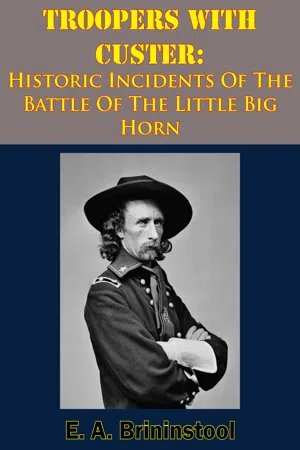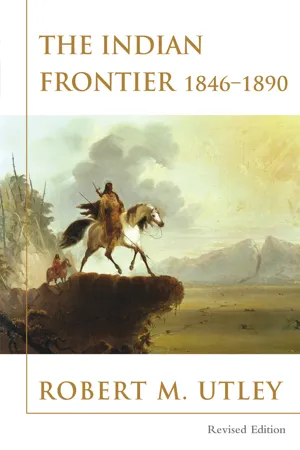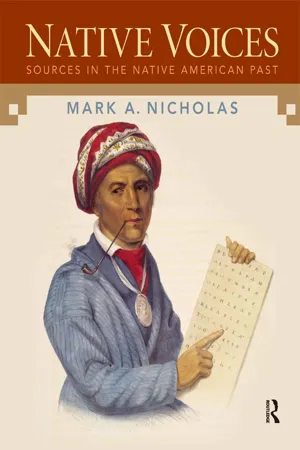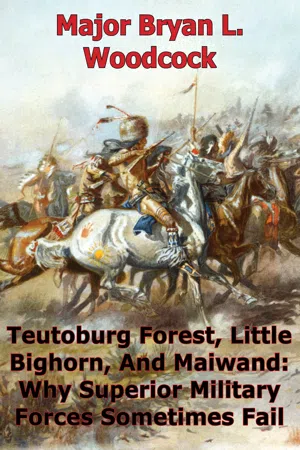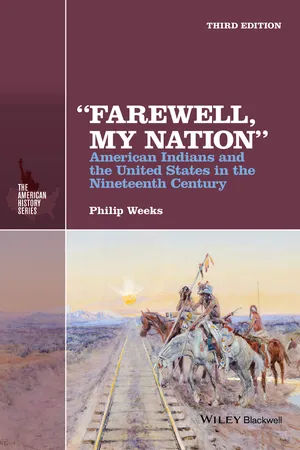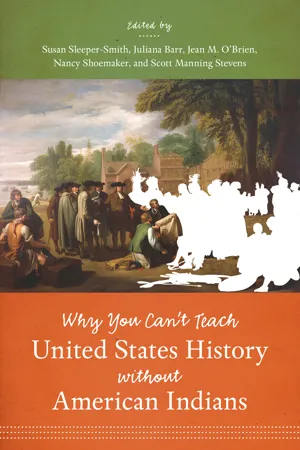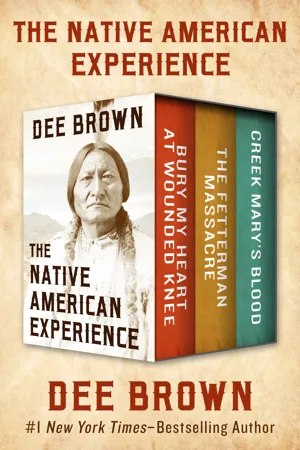History
Great Sioux War
The Great Sioux War, also known as the Black Hills War, was a series of conflicts between the Lakota Sioux and Northern Cheyenne tribes and the United States government. The war culminated in the Battle of the Little Bighorn in 1876, where the Sioux and Cheyenne achieved a significant victory over the U.S. Army. The war ultimately led to the defeat and confinement of the Native American tribes onto reservations.
Written by Perlego with AI-assistance
Related key terms
Related key terms
1 of 4
Related key terms
1 of 3
7 Key excerpts on "Great Sioux War"
- E. A. Brininstool(Author)
- 2015(Publication Date)
- Normanby Press(Publisher)
CHAPTER 1 — THE CUSTER FIGHT IN BRIEF
TO THE AVERAGE AMERICAN little is known regarding the actual facts surrounding the battle of the Little Big Horn. Perhaps he has read brief extracts, or heard others discuss the affair, and it therefore seems fitting that the story of this greatest of Indian battles should be briefly told, the main reason being to correct some of the exaggerated stories which have been broadcast over the years, and to refute others which have been foisted on the public by persons who were not in possession of the actual facts.The battle of the Little Big Horn was the culmination of the invasion of the Black Hills of Dakota (ceded Sioux territory) by white gold hunters. Custer, in 1874, led a government expedition into that then unexplored and unknown region, under orders to “spy out the land,” and determine if the stories in circulation regarding its beauty and wealth were true. It was hinted that gold was there—in abundance—and where gold is, there the white man will go, regardless of treaties or the rights of anyone of whatever race or color.After Custer had discovered and reported that there was gold in the Hills, a general stampede into the forbidden territory followed. In spite of the fact that the treaty of 1868 with the Sioux distinctly specified that “no white man should ever set foot in the territory without the consent of the Indians,” no attention whatever was paid to this edict. Gold had been discovered—and what else mattered?The Sioux resented this invasion of their ceded territory—and rightly! But the government could not keep the gold-maddened miners out, although a feeble attempt was made in that direction. The protests of the Sioux went unheeded, and it soon became apparent that armed resistance was imminent.Sitting Bull, the great medicine man of the Sioux nation—not a fighting chief in the strict sense of the word—was the leading fomenter among the Indians. He was a great schemer, a conjurer, with an immense following, particularly among the young men of the tribe. He was not an agency Indian but had a most bitter hatred for the “pale-face.” He preferred to roam, refusing to accept the agency rations doled out to him by the “great Father” at Washington, choosing instead to live by the chase as long as the buffalo were plentiful. His camp, in 1876, was supposed to be located somewhere in the Big Horn country of Wyoming, or in the adjacent Montana wilderness—just where was not known, as that entire section, in 1876, was an unsettled and all but unexplored region.- eBook - ePub
- Robert M. Utley(Author)
- 2003(Publication Date)
- University of New Mexico Press(Publisher)
National Archives.Fig. 65: Sitting Bull. The Hunkpapa Sioux chieftain held great power among the hunting bands that refused to settle on the reservation and fashioned the mighty coalition of tribes that overwhelmed Custer at the Little Bighorn in 1876. Forced to surrender in 1881, he remained resolutely opposed to all features of the government's civilization program. Indian policemen shot and killed him during the Ghost Dance troubles of 1890. National Archives.By mid-June the Indians camped on a creek that ran into a river they knew as the Greasy Grass. Earlier, on the Rosebud, they had staged their annual Sun Dance. Sitting Bull had experienced a vision, in which he saw many dead soldiers “falling right into our camp.” The people had thrilled to the image and the promise. Now scouts brought word of soldiers marching down the Rosebud. Crazy Horse led a large force to do battle. For six hours they fought, and after the Indians called off the fight the soldiers retreated.But this was not the triumph foretold by Sitting Bull. Soldiers had not fallen into their camp. Down to the Greasy Grass the village moved, and here the largest number yet of agency Indians joined the alliance. Six separate tribal circles—Hunkpapa, Oglala, Miniconjou, Sans Arc, Blackfoot, Northern Cheyenne—extended for three miles along the banks of the Greasy Grass. The village counted twelve hundred lodges and mustered almost two thousand fighting men.True to Sitting Bull's prophecy, many soldiers were about to fall into this village. As in the Red River War, General Sheridan had plotted a strategy of convergence. Advancing from the south, General Crook had struck the camp on Powder River on March 17 but had been driven back by winter. In May he sallied forth again, only to be stopped and turned back at the Battle of the Rosebud on June 17. Meantime, General Alfred H. Terry approached from the east and Colonel John Gibbon from the west. They joined on the Yellowstone at the mouth of the Rosebud. From here Terry launched a striking force of some six hundred cavalry, under the same Long Hair Custer who had invaded the Black Hills two years earlier. Custer followed the Indian trail up the Rosebud, across the Wolf Mountains, and down to the Greasy Grass, which his map labeled the Little Bighorn. The village there, because of the recent arrivals of agency Indians, contained about three times as many warriors as he had expected. On the scorching Sunday of June 25, 1876, his soldiers fell into it. - eBook - ePub
Native Voices
Sources in the Native American Past
- Mark Nicholas(Author)
- 2016(Publication Date)
- Routledge(Publisher)
Pahá Sápa, was the central geological feature within the sacred landscape of the Sioux. The importance of the Black Hills to the Sioux cannot be overstated.In the 1870s, the northern plains’ war broke out again between the Sioux and the United States, and the Black Hills was central to the struggle known as the Great Sioux War, waged from 1876 to 1877. The earnestness on both sides during the war had everything to do with the Black Hills territory and conflicting ideas about the region’s significance: For the Sioux, it was their land, and it was sacred; for American prospectors, it was an untouched area from which to harvest gold. The United States, in the midst of an economic crisis and ineffective at keeping western fortune seekers looking for gold from entering the Black Hills, abrogated Sioux treaty rights to the Black Hills, agreed upon in the second Fort Laramie Treaty of 1868. The Sioux, responding to the transgressions of the United States, factionalized. Ordered to move to their reserved tracts by the United States, the Sioux responded in two ways. Red Cloud and his followers accommodated and settled near the Red Cloud agency, a precursor to the Sioux reservations, located along the Platte River, just south from Fort Laramie. Red Cloud agency, staffed by American field agents, doled out weekly rations and annuity payments to Red Cloud and his Oglala followers. The militant Sioux led by Sitting Bull (Hunkpapa Lakota Sioux) and Crazy Horse (Oglala Lakota Sioux) stalwartly refused, and the Sioux under their leadership went to war with the United States. In a tactical maneuver to try for a swift victory over the Sioux, the United States turned to Crow and Shoshone warriors whose enmity against their Sioux rivals stretched back generations, and who were emboldened by the idea of eliminating the Sioux to elevate their own status and power on the plains. Both Crow and Shoshone warriors therefore joined the ranks of General George Armstrong Custer’s army. - eBook - ePub
- Major Michael T. Grissom(Author)
- 2014(Publication Date)
- Tannenberg Publishing(Publisher)
CHAPTER 3 — THE BATTLE OF THE LITTLE BIGHORN
It is a good day to die! – Lakota battle cry — Robinson, A Good Year to DieMuch as Rome spread across Europe centuries earlier, in the nineteenth century the United States was spreading across North America. Manifest Destiny was the predominant idea, and fighting battles became necessary as some of the people already on those lands sought to resist. One of those battles was the Battle of the Little Bighorn, arguably one of the most analyzed battles in American history. The battle is also a tantalizing riddle, since some of the most important elements, such as Custer’s last stand, were not witnessed by any living white men, and the Sioux narratives are difficult to fully interpret. Nevertheless, the facts of the battle are plain enough; tribal warriors from a primitive society defeated a professional army from a technologically advanced society who were armed with superior weaponry. The intent of this chapter is to unravel how this may have transpired, and to later establish the relationship between this battle and others of its kind.Strategic Situation
The U.S. Army
During the latter half of the nineteenth century the United State was advancing westward across the continent at a rapid, if uneven pace. Naturally, this meant the dispossession of the Indian tribes who were already occupying those lands. Although the United States policy varied somewhat throughout this time period, the political resolution was that Indians were steadily pushed westward onto reservations set aside for them. The reality of this situation, however, was that the federal government did not have the means, military or political, to prevent white settlement of even these areas.{122} White settlers sometimes occupied these reservations, or portions of the reservations, especially if there were resources such as gold on them. A notable example of this occurred in 1874 when Custer led an Army expedition to scout for gold in the Black Hills.{123} The United States had previously ceded this territory to the Sioux Indians in the Fort Laramie Treaty signed by the chief Red Cloud.{124} Under President Ulysses Grant, the United States ceased enforcement of this treaty, and no longer attempted to prevent white incursions in the Black Hills, which was considered sacred hunting ground by the Sioux.{125} - eBook - ePub
"Farewell, My Nation"
American Indians and the United States in the Nineteenth Century
- Philip Weeks(Author)
- 2015(Publication Date)
- Wiley-Blackwell(Publisher)
When no word from Custer arrived by June 26, Terry and Gibbon continued the march toward Sitting Bull’s camp, reaching their destination the following morning, Tuesday, June 27. They rescued Reno, Benteen, and the survivors of their companies. They also discovered the remains of soldiers strewn throughout the general area of the battle, and the location—soon to be called “Last Stand Hill”—where Custer and all of his command perished. General Terry recorded that day: “It is marked by the remains of his officers and men and the bodies of his horses, some of them strewed along the path, others heaped where halts appear to have been made.” The sight appalled both the troops and their two commanders: “A scene of sickening, ghastly horror,” one soldier recalled after viewing the corpses littering the battlefield, many of whom were stripped and mutilated. Within several days, the entire nation shared their feelings.The Great Sioux War Concludes
A terse telegraph message conveyed the news eastward: “Bismarck, D.T. [Dakota Territory], July 5, 1876:—General Custer attacked the Indians June 25, and he, with every officer and man in five companies, were killed.” Reports of the Battle of the Little Bighorn shocked an incredulous American public on July 6th, in the midst of the republic’s jubilant celebration of its centennial. Philip Sheridan and many of the military’s senior officers learned of the battle while in Philadelphia, the city where the Continental Congress had adopted the Declaration of Independence a hundred years earlier in July, 1776. The officers were attending the centennial exposition celebrating the theme “A Century of Progress” when the news arrived. At first Sheridan refused to believe the initial Associated Press wire story. The arrival of General Alfred Terry’s confidential report left no doubt about the annihilation of Custer and the five companies of the Seventh Cavalry. As newspapers across the country printed the report about the battle, the nation clamored for revenge against the Indians.Not everyone pardoned George Custer. A commentator editorialized in The Nation magazine: “We admire the gallantry of General Custer and his men, but who shall blame the Sioux for defending themselves?” President Grant assessed: “I regard Custer's Massacre as a sacrifice of troops, brought on by Custer himself, that was wholly unnecessary—wholly unnecessary.” General Terry’s report clearly attributed the Little Bighorn disaster to the commander of the Seventh Cavalry’s egregious conduct. “Custer’s action is inexplicable in the case,” Terry evaluated.That the analysis of Custer’s commanding officer was accurate was the least of the American public’s concerns. The legend of the man and the event soon christened “Custer’s Last Stand” was born almost immediately after the battle, and it continued to grow in the years following his death. The legend is replete with irony. George Armstrong Custer finally attained heroic immortality and achieved the lasting fame that he tirelessly sought on numerous battlefields during the Civil War and the Plains Indian wars—not by means of a breathtaking victory, but through complete and utter defeat. - Susan Sleeper-Smith, Juliana Barr, Jean M. O'Brien, Nancy Shoemaker, Scott Manning Stevens, Susan Sleeper-Smith, Juliana Barr, Jean M. O'Brien, Nancy Shoemaker, Scott Manning Stevens(Authors)
- 2015(Publication Date)
- The University of North Carolina Press(Publisher)
For Cheyenne leaders such as Black Kettle, Sand Creek was not an aberration or isolated moment of violence. He survived the massacre at Sand Creek, but that would not be the end of his story. Black Kettle joined with fellow survivors and regrouped with other Cheyenne, but now they were restricted to Indian Territory by the 1867 Medicine Lodge Treaty. This treaty alienated the Southern Cheyenne from their traditional homelands and put them into conflict with competing Indian nations in the territory. When a loose intertribal alliance began attacking white settlements in western Kansas and southern Colorado, the same rhetoric that had preceded the attack on Sand Creek could be heard again. In November of 1868 at the Battle of Washita River, Black Kettle was killed by the troops of General George Armstrong Custer. The violence of the Civil War period bled unimpeded into the era of the Indian wars.The frontier for the Native nations of North America was a place of frequent military conflicts and almost constant pressures from land-hungry settlers. More disturbing perhaps is the fact that most of these events, defining historical events to the Native nations involved, are all but forgotten by members of the majority culture. To be sure, the events of the Dakota War must have haunted the American imagination well into the end of the nineteenth century. The eruption of Indian violence into the settler home front was a traumatic event that surely colored Indian policy well beyond 1862. We cannot treat these events as microhistories or they will continue to be obscured and forgotten in the macronarrative of the U.S. Civil War. In a sense we must strive to reconnect these events to the two decades of the “Indian wars” that followed directly on the heels of the Civil War. Those conflicts of the 1870s and 1880s provided the recently re-United States with a common enemy, Indians, and a common prize, their lands. The Civil War takes our eyes off of Indian Country but it remains an ever-present backdrop—it was the opening of the contested lands that acted as a catalyst to the crisis regarding the extension of slavery, and it was the prize of land and resources that made its conquest after the war so enticing.- eBook - ePub
The Native American Experience
Bury My Heart at Wounded Knee, The Fetterman Massacre, and Creek Mary's Blood
- Dee Brown(Author)
- 2017(Publication Date)
- Open Road Media(Publisher)
34Regardless of who had killed him, the Long Hair who made the Thieves’ Road into the Black Hills was dead with all his men. Reno’s soldiers, however, reinforced by those of Major Frederick Benteen, were dug in on a hill farther down the river. The Indians surrounded the hill completely and watched the soldiers through the night, and next morning started fighting them again. During the day, scouts sent out by the chiefs came back with warnings of many more soldiers marching in the direction of the Little Bighorn.After a council it was decided to break camp. The warriors had expended most of their ammunition, and they knew it would be foolish to try to fight so many soldiers with bows and arrows. The women were told to begin packing, and before sunset they started up the valley toward the Bighorn Mountains, the tribes separating along the way and taking different directions.When the white men in the East heard of the Long Hair’s defeat, they called it a massacre and went crazy with anger. They wanted to punish all the Indians in the West. Because they could not punish Sitting Bull and the war chiefs, the Great Council in Washington decided to punish the Indians they could find—those who remained on the reservations and had taken no part in the fighting.On July 22 the Great Warrior Sherman received authority to assume military control of all reservations in the Sioux country and to treat the Indians there as prisoners of war. On August 15 the Great Council made a new law requiring the Indians to give up all rights to the Powder River country and the Black Hills. They did this without regard to the treaty of 1868, maintaining that the Indians had violated the treaty by going to war with the United States. This was difficult for the reservation Indians to understand, because they had not attacked United States soldiers, nor had Sitting Bull’s followers attacked them until Custer sent Reno charging through the Sioux villages.
Index pages curate the most relevant extracts from our library of academic textbooks. They’ve been created using an in-house natural language model (NLM), each adding context and meaning to key research topics.
Explore more topic indexes
Explore more topic indexes
1 of 6
Explore more topic indexes
1 of 4
